Payment terminal
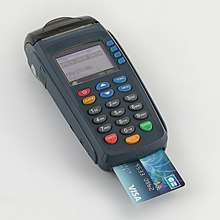
A payment terminal, also known as a point of sale terminal, credit card terminal, EFTPOS terminal (or a PDQ terminal which stands for "Process Data Quickly"[1]), is a device which interfaces with payment cards to make electronic funds transfers.
There are various types of terminals available to merchants, although most have the same basic purpose and functions. They allow a merchant to insert, swipe, or manually enter the required credit/debit card information, as well as to accept NFC Contactless transactions, and to transmit this data to the merchant service provider for authorization and finally, to transfer funds to the merchant.
Higher end models not only process credit and debit cards but also serve as a comprehensive customer engagement screen at the checkout. Common features include but are not limited to the ability to process gift cards, cheques, contactless and mobile wallet payments. Some are also programmed to accept store loyalty cards or allow the customer to use the pin pad to enter their information (ex. phone number) to redeem points. POS screens also allow retailors to advertise near the register when the terminal isn't being used.[2] During the checkout process, many terminals are set to display a list of items purchased along with the running total. Other times, this functionality may be turned off or it may be used to supplement a dedicated screen that lists items being purchased. Some stores also use the terminal for customers to view and agree to the terms of a product warranty. Like ATMs, many POS terminals are also equipped raised tactile buttons and an earphone jack which allow the blind to audibly finish the payment process.[3][4]
The majority of card terminals transmit data over a standard telephone line or an internet connection. Some also have the ability to cache transactional data to be transmitted to the gateway processor when a connection becomes available; the major drawback to this is that immediate authorization is not available at the time the card was processed, which can subsequently result in failed payments. Wireless terminals transmit card data using Bluetooth, Wi-Fi, cellular,[5] or even satellite networks in remote areas and onboard airplanes.
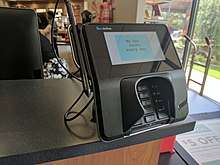
A merchant can replace the functionality of dedicated credit card terminal hardware using a terminal application running on a PC or mobile device, such as a smartphone. They usually work with dedicated hardware readers that can transfer magnetic stripe data to the application, while there are also some that also work with smart cards (using technology such as EMV), although this is rarely seen on smartphone readers. In case the necessary hardware is unavailable, these applications usually support manual entry of the card number and other data. In addition, more and more devices are beginning to offer built-in RFID or NFC technology to accommodate contactless or mobile device payment methods, often without requiring additional external hardware.[6]
By moving to the use of card terminals to directly capture card information instead of manually entering in card details, merchants benefit from the efficiency of decreased transaction processing times. In terms of security, major card terminal manufacturers usually offer software allowing end to end card data encryption.[7] Still, there have been some cases of POS pin pad malware. In countries such as the US, where magnetic stripe cards aren't fully phased out, there have also been incidence of skimming at card terminals.[8] That said, stand alone payment terminals are seen as superior to register attached payment methods because they don't require store cashers to take possession of the customer's card.
History
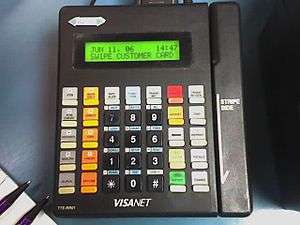
Prior to the development of payment terminals, merchants would use Manual Imprinters (also known as ZipZap machines) to capture the information from the embossed information on a credit card onto a paper slips with carbon paper copies.[9] These paper slips had to be taken to the bank for processing. This was a cumbersome and time consuming process.
Point of sale terminals emerged in 1979, when Visa introduced a bulky electronic data capturing terminal which was the first payment terminal. In the same year magnetic stripes were added to credit cards for the first time.[10] This allowed card information to be captured electronically and led to the development of payment terminals.
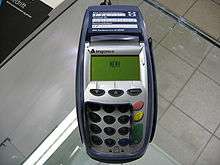
One of the first companies to produce dedicated payment terminals was Verifone. It started in 1981 in Hawaii as a small electronic company. In 1983 they introduced the ZON terminal series which would become the standard for modern payment terminals.
Hungarian born George Wallner in Sydney, Australia founded rival Hypercom in 1978 and in 1982 started producing dedicated payment terminals. It went on to dominate the south pacific region. In 1988 the company signed a deal with American Express to provide its terminals to them in the US. To consolidate the deal, Hypercom moved its head office from Australia to Arizona in the US. It then faced head to head competition with VeriFone on its home market.[11]
Over a decade later in 1994 Lipman Electronic Engineering, Ltd. was established in Israel. Lipman manufactured the Nurit line of processing terminals. Because of Verifone’s already firm place in the payment processing industry when Lipman was established, Lipman targeted an untapped niche in the processing industry. While, Lipman holds about a 10% share in wired credit card terminals, they are the undisputed leader with more than 95% share in wireless processing terminals in the late 1990s.
Verifone would later acquired both of these major rivals, acquiring Lipman in 2006 and the payment part of the Hypercom business including its brand in 2011.
In 1980 Jean-Jacques Poutrel and Michel Malhouitre in 1980 established Ingenico in France and developed their first payment terminal in 1984. Its Barcelona-based R&D unit would lead the development of payment terminals for the next decade. Ingenico, through a number of acquisitions, would dominate the European market for payment terminals. They acquired French based Bull and UK based De La Rue payment terminal activity as well as German Epos in 2001.[12]
Initially, information was captured from the magnetic strip on the back of the card, by swiping the card through the terminal. In the late 1990s, this started to be replaced by smart cards where the chip was embedded in the card. This was done for added security and required the card to be inserted into the credit card terminal. In the late 1990s and early 2000s contactless payment systems were introduced and the payment terminals were updated to include the ability to read this these cards using near field communication (NFC) technology.
Typical features
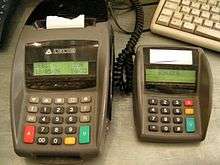
- Key entry (for customer not present mail and telephone order)
- Tips/gratuities
- Refunds and adjustments
- Settlement (including automatic)
- Pre-authorisation
- Payments using near field communication enabled devices
- Remote initialisation and software update
- POS integration
- Semi-integrated POS
- Multi-merchant capabilities
- Pen or PIN authorization by the customer
- Surcharge function
- Secure password operation
Major manufacturers
.jpg)
There are 3 main global players who offer both a wide range of payment terminals, sell worldwide, and have the long-term financial solidity to remain invested in upgrading payment terminals to the latest international payment industry standards.[13]
See also
References
- ↑ Transversal, James Leslie at. "Ask Barclaycard a question". ask.barclaycard.co.uk. Retrieved 2017-09-28.
- ↑ "MX 915". Verifone.com. Retrieved 2017-09-13.
- ↑ "iSC Touch 480". ingenico.us. Retrieved 2017-09-13.
- ↑ "Talking ATM Overview - Wells Fargo". www.wellsfargo.com. Retrieved 2017-09-13.
- ↑ "Ingenico Group - Expertise - Pay-at-the-Table". ingenico.us. Retrieved 2017-09-13.
- ↑ Whitney, Lance (2011-03-24). "App turns Google Nexus phone into payment tool". CNET. Retrieved March 24, 2015.
- ↑ "Gateways". Verifone.com. Retrieved 2017-09-13.
- ↑ "ATM 'Shimmers' Target Chip-Based Cards — Krebs on Security". krebsonsecurity.com. Retrieved 2017-09-13.
- ↑ "Glossary zipzap-machine". creditcards.com. Retrieved September 18, 2017.
- ↑ Jamie Estep (April 12, 2006). "The History of Credit Card Terminals".
- ↑ "Hypercom Corporation History". Funding Universe. Retrieved December 8, 2015.
- ↑ "Ingenico - Our history". Retrieved December 28, 2016.
- ↑ "How the Top 3 Card Machine Manufacturers are Redefining the Payment Industry". ExpertSure. Retrieved December 29, 2017.